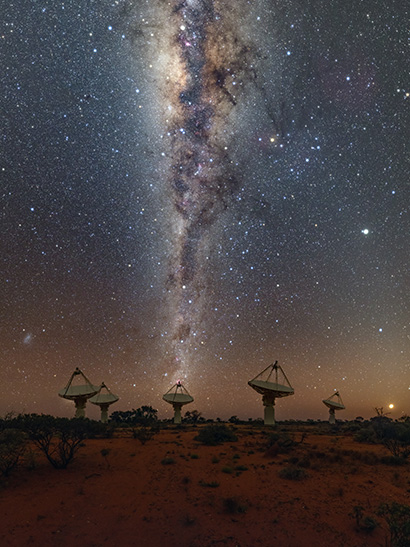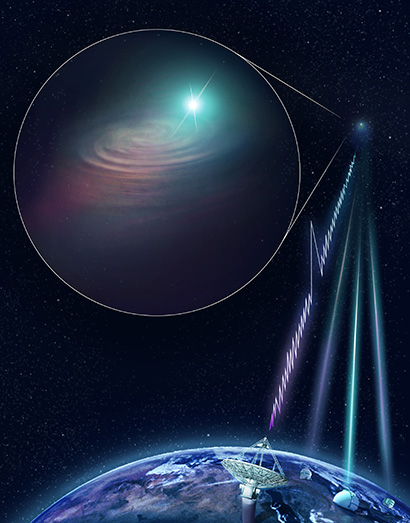In a world first, an international team of astronomers has determined the precise location of a powerful one-off burst of cosmic radio waves known as a fast radio burst.
The discovery was made with the new Australian Square Kilometer Array Pathfinder (ASKAP), a 36-dish radio telescope in Western Australia owned and operated by the Commonwealth Science and Industrial Research Organisation (CSIRO).
A team coordinated by UC Santa Cruz astronomer J. Xavier Prochaska performed follow-up observations of the galaxy from which the burst originated, using three of the world’s largest optical telescopes. The new findings were published online by the journal Science on Thursday, June 27.
“This is the big breakthrough the field has been waiting for since astronomers discovered fast radio bursts in 2007,” said CSIRO's Keith Bannister, lead author of the paper.
Since then, a global hunt has netted 85 fast radio bursts. Most have been ‘one-offs’ but a small fraction are ‘repeaters’ that recur at the same spot in the sky. In 2017, astronomers found a repeater’s host galaxy, but localizing a one-off burst had been unattainable, until now.
Prochaska's team measured the distance to the new burst's host galaxy with the 10-meter Keck II Telescope in Hawaii, then obtained follow-up imaging and spectra with the European Southern Observatory’s 8-meter Very Large Telescope and the 8-meter Gemini South telescope, both in Chile.
“Identifying the galaxy that hosted the event and measuring its distance are key to figuring out what generates these enigmatic bursts,” said Prochaska, a professor of astronomy and astrophysics at UC Santa Cruz. “Amazingly, the galaxy for FRB 180924 is completely different from the repeater’s home galaxy.”
Fast radio bursts last less than a millisecond, making it difficult to detect them and even harder to accurately measure where they have come from. Bannister’s team developed new technology that can replay the data from when the burst occurred, allowing the location to be determined. This technology was used to pinpoint the location of FRB 180924 to its home galaxy (DES J214425.25−405400.81), about 3.6 billion light-years away.
"It's like looking at the Earth from the Moon and not only knowing what house a person lived in, but what chair they were sitting in at the dining room table," Bannister said.
ASKAP is the first telescope to both find large numbers of fast radio bursts and identify their origins, thanks to its unique design and signal processing power. Since ASKAP is an array of 36 dish antennas and the burst had to travel a slightly different distance to each dish, it reached each one at a slightly different time.
“From these tiny time differences—just a fraction of a billionth of a second—we identified the burst’s home galaxy and even its exact starting point, 13,000 light-years out from the galaxy’s center in the galactic suburbs,” said team member Adam Deller of Swinburne University of Technology.
The cause of fast radio bursts remains unknown, but the ability to determine their exact location is a big leap towards solving this mystery. Independently, it also gives astronomers a new way to study the diffuse material that occupies the spaces between galaxies, known as the intergalactic medium, because of the way that material affects the radio waves in the burst.
“These data offer an entirely new method to measure the amount of matter in the cosmos,” Prochaska said.
The localization of the radio burst was done as part of a science project using ASKAP called CRAFT (Commensal Real-time ASKAP Fast Transients) that is jointly led by Bannister, Jean-Pierre Macquart of the Curtin University node of the International Centre for Radio Astronomy Research, and Ryan Shannon of Swinburne University of Technology. Shannon and CSIRO astronomer Shivani Bhandari carried out the observations and were the first to spot the burst.
UCSC graduate student Sunil Simha also carried out the optical observations, along with Nicolas Tejos (Pontificia Universidad Catolica de Valparaiso, Chile) and Stuart Ryder (Macquarie University, Australia).
ASKAP is located at CSIRO’s Murchison Radio-astronomy Observatory in Western Australia and is a precursor for the future Square Kilometre Array telescope. CSIRO acknowledges the Wajarri Yamaji as the traditional owners of the MRO site.





